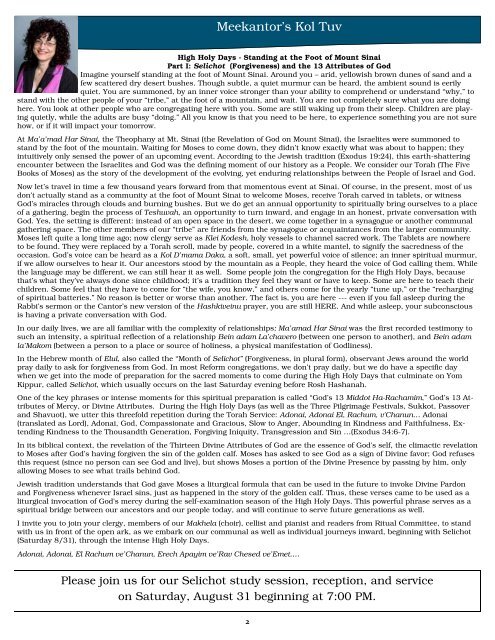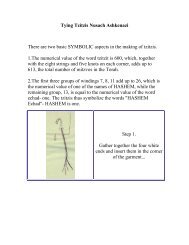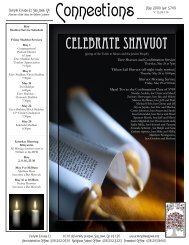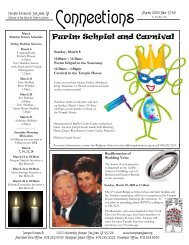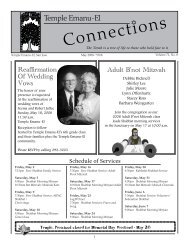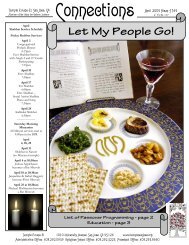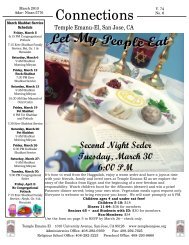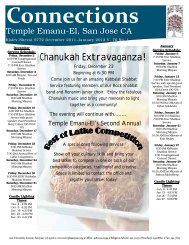Current - Temple Emanu-El
Current - Temple Emanu-El
Current - Temple Emanu-El
You also want an ePaper? Increase the reach of your titles
YUMPU automatically turns print PDFs into web optimized ePapers that Google loves.
Meekantor’s Kol Tuv<br />
High Holy Days - Standing at the Foot of Mount Sinai<br />
Part I: Selichot (Forgiveness) and the 13 Attributes of God<br />
Imagine yourself standing at the foot of Mount Sinai. Around you – arid, yellowish brown dunes of sand and a<br />
few scattered dry desert bushes. Though subtle, a quiet murmur can be heard, the ambient sound is eerily<br />
quiet. You are summoned, by an inner voice stronger than your ability to comprehend or understand “why,” to<br />
stand with the other people of your “tribe,” at the foot of a mountain, and wait. You are not completely sure what you are doing<br />
here. You look at other people who are congregating here with you. Some are still waking up from their sleep. Children are playing<br />
quietly, while the adults are busy “doing.” All you know is that you need to be here, to experience something you are not sure<br />
how, or if it will impact your tomorrow.<br />
At Ma’a’mad Har Sinai, the Theophany at Mt. Sinai (the Revelation of God on Mount Sinai), the Israelites were summoned to<br />
stand by the foot of the mountain. Waiting for Moses to come down, they didn’t know exactly what was about to happen; they<br />
intuitively only sensed the power of an upcoming event. According to the Jewish tradition (Exodus 19:24), this earth-shattering<br />
encounter between the Israelites and God was the defining moment of our history as a People. We consider our Torah (The Five<br />
Books of Moses) as the story of the development of the evolving, yet enduring relationships between the People of Israel and God.<br />
Now let’s travel in time a few thousand years forward from that momentous event at Sinai. Of course, in the present, most of us<br />
don’t actually stand as a community at the foot of Mount Sinai to welcome Moses, receive Torah carved in tablets, or witness<br />
God’s miracles through clouds and burning bushes. But we do get an annual opportunity to spiritually bring ourselves to a place<br />
of a gathering, begin the process of Teshuvah, an opportunity to turn inward, and engage in an honest, private conversation with<br />
God. Yes, the setting is different: instead of an open space in the desert, we come together in a synagogue or another communal<br />
gathering space. The other members of our “tribe” are friends from the synagogue or acquaintances from the larger community.<br />
Moses left quite a long time ago; now clergy serve as Klei Kodesh, holy vessels to channel sacred work. The Tablets are nowhere<br />
to be found. They were replaced by a Torah scroll, made by people, covered in a white mantel, to signify the sacredness of the<br />
occasion. God’s voice can be heard as a Kol D’mama Daka, a soft, small, yet powerful voice of silence; an inner spiritual murmur,<br />
if we allow ourselves to hear it. Our ancestors stood by the mountain as a People, they heard the voice of God calling them. While<br />
the language may be different, we can still hear it as well. Some people join the congregation for the High Holy Days, because<br />
that’s what they’ve always done since childhood; it’s a tradition they feel they want or have to keep. Some are here to teach their<br />
children. Some feel that they have to come for “the wife, you know,” and others come for the yearly “tune up,” or the “recharging<br />
of spiritual batteries.” No reason is better or worse than another. The fact is, you are here --- even if you fall asleep during the<br />
Rabbi’s sermon or the Cantor’s new version of the Hashkiveinu prayer, you are still HERE. And while asleep, your subconscious<br />
is having a private conversation with God.<br />
In our daily lives, we are all familiar with the complexity of relationships; Ma’amad Har Sinai was the first recorded testimony to<br />
such an intensity, a spiritual reflection of a relationship Bein adam La’chavero (between one person to another), and Bein adam<br />
la’Makom (between a person to a place or source of holiness, a physical manifestation of Godliness).<br />
In the Hebrew month of <strong>El</strong>ul, also called the “Month of Selichot” (Forgiveness, in plural form), observant Jews around the world<br />
pray daily to ask for forgiveness from God. In most Reform congregations, we don’t pray daily, but we do have a specific day<br />
when we get into the mode of preparation for the sacred moments to come during the High Holy Days that culminate on Yom<br />
Kippur, called Selichot, which usually occurs on the last Saturday evening before Rosh Hashanah.<br />
One of the key phrases or intense moments for this spiritual preparation is called “God’s 13 Middot Ha-Rachamim,” God’s 13 Attributes<br />
of Mercy, or Divine Attributes. During the High Holy Days (as well as the Three Pilgrimage Festivals, Sukkot, Passover<br />
and Shavuot), we utter this threefold repetition during the Torah Service: Adonai, Adonai <strong>El</strong>, Rachum, v'Chanun… Adonai<br />
(translated as Lord), Adonai, God, Compassionate and Gracious, Slow to Anger, Abounding in Kindness and Faithfulness, Extending<br />
Kindness to the Thousandth Generation, Forgiving Iniquity, Transgression and Sin …(Exodus 34:6-7).<br />
In its biblical context, the revelation of the Thirteen Divine Attributes of God are the essence of God's self, the climactic revelation<br />
to Moses after God’s having forgiven the sin of the golden calf. Moses has asked to see God as a sign of Divine favor; God refuses<br />
this request (since no person can see God and live), but shows Moses a portion of the Divine Presence by passing by him, only<br />
allowing Moses to see what trails behind God.<br />
Jewish tradition understands that God gave Moses a liturgical formula that can be used in the future to invoke Divine Pardon<br />
and Forgiveness whenever Israel sins, just as happened in the story of the golden calf. Thus, these verses came to be used as a<br />
liturgical invocation of God's mercy during the self-examination season of the High Holy Days. This powerful phrase serves as a<br />
spiritual bridge between our ancestors and our people today, and will continue to serve future generations as well.<br />
I invite you to join your clergy, members of our Makhela (choir), cellist and pianist and readers from Ritual Committee, to stand<br />
with us in front of the open ark, as we embark on our communal as well as individual journeys inward, beginning with Selichot<br />
(Saturday 8/31), through the intense High Holy Days.<br />
Adonai, Adonai, <strong>El</strong> Rachum ve’Chanun, Erech Apayim ve’Rav Chesed ve’Emet….<br />
Please join us for our Selichot study session, reception, and service<br />
on Saturday, August 31 beginning at 7:00 PM.<br />
2


